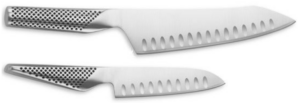Trade mark for patented product – Global Yoshikin
The case: Yoshida Metal Industry applied, simultaneously with patent protection, for trade mark protection in the European Union for the product shape of its particular Global Yoshikin knife handles. The protection of the knives was to be extended by the trade mark beyond the patent term for a virtually unlimited period of time. After a battle lasting 17 years, 2 instances and 7 appeals, Yoshida ultimately had to abandon its goal. Why was this case so difficult to decide?
Everyone has encountered the ‘Global Yoshikin Knives’ by Yoshida:

In the course of trade mark protection, the following two figurative marks were applied for in the European Union:


Initially, Yoshida’s plan worked. The two figurative marks were registered in the trade mark register following a rejection on appeal.
However, resistance soon arose. Competitors filed applications for invalidity, arguing that the marks actually depicted the shape of the handles of the Global Yoshikin knives. In addition to the outlines of the handles, the essential elements of the mark were the black dots. These represented the dents on the handles, which were intended to make the knives non-slip. Trade mark protection should not be granted for technical solutions.
Yoshida disagreed. The black dots are only arbitrary decorations. Only the position of coloured dots on the handles would be indicated. There would be no technical effect. Design and position marks are allowed.
This was a successful argument all the way to the Court of Justice of the European Union. However, the first judgment of the European Court of Justice turned the tide, and in its second judgment, the Court finally confirmed the cancellation of the trade marks.
It was clear from the patent specifications for the knives that the dots in the registered figurative marks were not in fact images, but in fact black-coloured dents on the handles of the knives, whose sole purpose was to achieve a technical solution, namely an anti-slip structure. It was irrelevant that the anti-slip effect of the dents was only achieved in combination with the shape of the knives.
It is true that the dents are also coloured. However, this was not an essential element of the handles. The design effect of the colouring was secondary to the technical effect of the dents. Thus, all the essential features of the graphic representation of the shape of the goods applied for had a technical function.
The trade mark right is not intended to lead to a monopoly on technical solutions or utility features of a product. The right only grants temporary direct protection to technical solutions or functional characteristics of a product. The fact that the knives were quickly recognisable did not help Yoshida.
The Court refused leave to appeal this assessment.
Court of Justice of the European Union, 11 May 2019, C-421/15 P.
Learnings: If you want to monopolise the shape of a product for an unlimited period of time via trade mark protection, make sure that not all essential features of the shape applied for have a technical effect at first step. Analyse the shape applied for very carefully. It may be that only the time-limited options of patent protection and utility model protection are available for the direct protection of your product.
See also the article:
Protection against counterfeiting – ground anchors